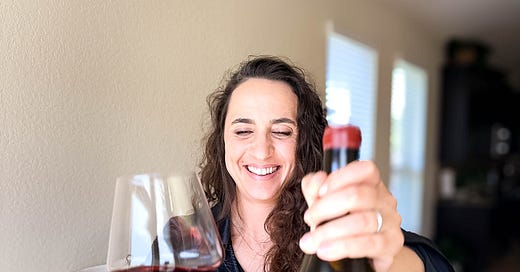Welcome to The Revival List, where forgotten wines get a second chance to shine.
Every other week I’ll introduce you to an under-the-radar grape or wine style that’s making a well-deserved comeback. These aren’t just delicious discoveries—they’re wines with history, crafted by passionate artisans who are keeping tradition alive while redefining the future of wine.
Expect to find your next favorite bottle, support small producers, champion diversity in the wine world, and have a great story to share at your next get-together. Because who doesn’t love a good comeback?
Here’s what we’ve covered so far:
This week we’re exploring a variety I’m trying for the very first time…Pineau d’Aunis!
This ancient grape hails from the storied vineyards of the Loire Valley—specifically near Anjou and the lesser-known Loir Valley (yes, that’s a different river!). Once beloved by nobility—King Henry III of England was reportedly a fan—Pineau d’Aunis was so popular in the Middle Ages that some even speculate it could have been one of the earliest grapes used in “Claret.”
But over time, its star faded. Misunderstood and replaced by more commercially viable varieties, Pineau d’Aunis became a footnote in France’s viticultural history. Today, it's enjoying a quiet but determined revival.
Fun fact: it’s also known as Chenin Noir, and genetically it’s a relative of Sauvignon Blanc—no wonder it feels right at home in the Loire.
A Unique French Gem Likely from the Loire Valley
The grape takes its name from the Prieuré d’Aunis, a medieval monastery still standing between Saumur and Champigny. The winemaking traditions of that priory live on thanks to the Pasquier family, who continue to craft wines in the Saumur-Champigny region.
If you’ve sipped a red or sparkling wine from Anjou or Saumur, there’s a good chance Pineau d’Aunis was part of the blend—though it may not have been listed on the label. Anjou is sort of a natural lover’s paradise where winemakers are coloring outside of the lines and putting their own stamp on Loire Valley varieties, including Pineau d’Aunis.
In Saumur-Champigny, for example, it’s permitted in blends alongside Cabernet Franc and Cabernet Sauvignon (up to 30%).
You’ll also find it in small but exciting quantities in Cheverny, Coteaux du Loir, and Coteaux du Vendômois—regions where it sometimes plays with other French grapes like Gamay, Pinot Noir, Grolleau, and Malbec.
And while it may have slipped into obscurity for a time, the grape’s heartland is the Loir Valley—a quieter, less-touristy sibling to the more famous Loire, running parallel to and just a bit farther north, but equally full of wine treasures waiting to be rediscovered.
Varietal Character & Wine Style
Flavors & Aromas: Pineau d’Aunis is nothing if not distinctive. A whisper of white pepper spice is its calling card, layered over wild red berries, sometimes dried flowers, incense, and hints of forest floor. The best examples are hauntingly aromatic, light on their feet, and just complex enough to keep you coming back.
Structure: Generally light- to medium-bodied, it brings bright acidity and, if handled with care, fine-grained tannins. But beware—if over-extracted, those tannins can get rustic fast.
Alcohol: Typically low to moderate—another reason it fits today’s trend toward lighter reds.
Ageability: The best reds can age gracefully for a few years, while rosés are usually meant to be enjoyed young and zippy. That said, I wouldn’t be surprised if a few well-made examples surprised us in the cellar.
In the glass, Pineau d’Aunis offers range. As a red, it’s chillable, vibrant, and spice-driven—perfect for fans of Pinot Noir or Gamay. In warmer years, the fruit skews juicier and more expressive. Cooler vintages lean into that peppery, mineral edge.
As a rosé, it’s electric. Crisp, citrusy, and refreshing, with serious structure and a saline streak. Think Provence but with a lot more attitude.
If You Enjoy These Wines, You’ll Love Pineau d’Aunis
Even though there's no genetic link, Pineau d’Aunis shares some vibes with Pinot Noir. It’s fragrant, food-friendly, and complex—yet somehow easier to love on the first sip. Add a pinch of spice and a dash of Loire Valley mystique, and you’ve got a new favorite in the making. Fans of Gamay, Cinault, or Counoise will like this variety, too.
Recommended Food Pairings
Pineau d’Aunis loves food. For reds, think charcuterie boards, roast chicken, grilled trout, or mushroom dishes that play off its earthy notes. Rosé versions pair beautifully with salty snacks, fresh goat cheese, and anything Mediterranean. It's also amazing with spiced dishes—Moroccan tagine or herby sausages, anyone?
Pineau d’Aunis in the Vineyard
This grape is known for being… temperamental. Hence why it fell out of favor with vignerons for decades. It produces small, uneven yields and is particularly prone to rot, mildew, and even pest damage. It’s picky about soil, favoring well-balanced sites with a mix of clay, sand, and gravel. Too much limestone and it ripens too fast. Too much clay and it’s dragging its feet.
In the winery, it’s no picnic either—its acidity and tannins can be tough to tame. But in the right hands, it shines.
Top Producers Worth Exploring




Deboutbertin “Aunis Etoilé” 2021 – A natural, soulful expression from a tiny estate worked by horse and hand. Think native fermentation, old-school pressing, and wines full of heart.
My tasting notes: This light-bodied red is surprisingly captivating with aromas of dried flowers, incense, and tart red fruits like cranberries and cherries. The palate pops with crunchy acidity and intrigue.
Domaine du Four À Chaux “Benjamin”– Earthy, incense-tinged, and wrapped in leathery tannins, this one leans more rustic, but still full of character.
Domaine de Bellivière “Rouge-Gorge” – A bit more muscular with robust tannins and dried floral notes. Not for the faint of heart, but definitely expressive.
Patrice Colin – One of the names to know in the Coteaux du Vendômois. His wines are elegant and lively, with just the right tension between fruit and spice.
Les Vignes Herbel – A natural wine darling producing honest, low-intervention expressions from near Anjou.
Alder Yarrow of Vinography has a pretty lengthy lineup at various price points that you can check out here, too.
Where to Buy Pineau d’Aunis in the U.S.
Fair warning—it can be a bit of a hunt. You’re not likely to stumble upon this one at your neighborhood wine shop (yet). Online retailers and natural wine stores are your best bet, especially those with a focus on the Loire or French natural wines. Keep your eyes peeled and maybe set up a search alert or two! I found some great options on Flat Iron Wine & Spirits, Thatcher’s Wine, Mysa, and Kermit Lynch.
Pineau d’Aunis is on Track for a Renaissance
In the 1970s, Pineau d’Aunis nearly disappeared entirely. Only about 40 acres remained. But thanks to a new generation of passionate growers and curious drinkers, it’s staging a quiet comeback—with about 1,100 acres now planted, mostly in the Loire Valley.
It’s not just a relic—it’s a wine for right now: low alcohol, high complexity, and totally distinctive. Sommeliers are geeking out over it. Wine lovers are catching on. And if you ask me, Pineau d’Aunis is a wine to watch (and definitely try).













Share this post